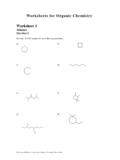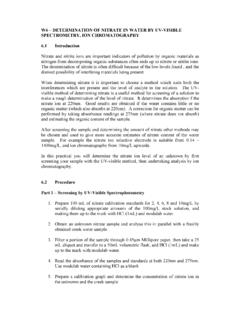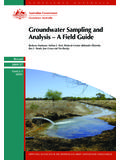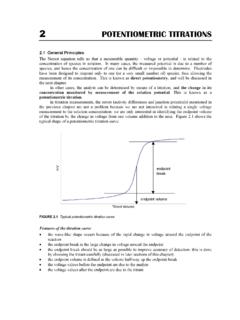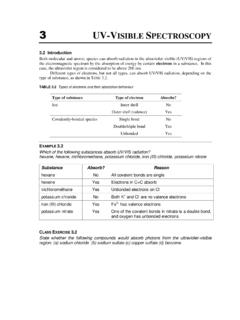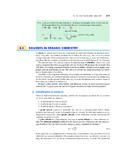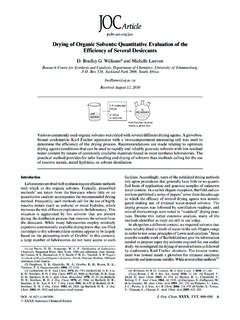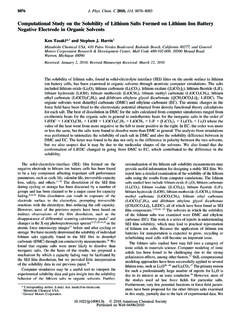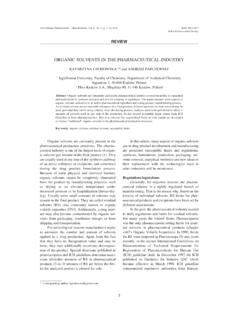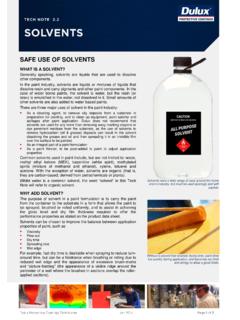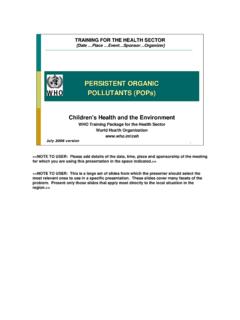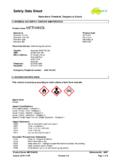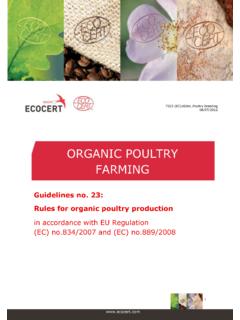Transcription of An Introduction to Organic Chemistry - cffet.net
1 Chem. Nat. Substances p Introduction to Organic Chemistry Theory Manual Written by Judy Gordon & Lara PasslowChem. Nat. Substances p Table of Contents An Introduction to Organic Chemistry .. 3 Functional Groups .. 6 Chemical Formulae and the Structures of Organic Compounds .. 8 Isomers .. 11 The IUPAC Naming System - How to Name Organic Compounds .. 12 19 The Alkanes .. 20 Alkenes and Alkynes .. 21 Types of Organic 25 Alkanols (alcohols).. 27 Haloalkanes .. 30 Alkanals and Alkanones .. 32 Hydrogen Bonding, Polar Functional Groups and Physical Properties .. 36 Alkanoic (carboxylic) Acids .. 40 Esters .. 46 Amines .. 51 Amides.
2 55 Ethers .. 56 Aromatics .. 58 Introduction to Organic Chemistry Chem. Nat. Substances p3 An Int roduct i on t o O rgani c Chem i stry Organic Chemistry is the study of carbon containing compounds and their properties. This includes the great majority of chemical compounds on the planet, but some substances such as carbonates and oxides of carbon are considered to be inorganic substances even though they contain carbon. Organic chemicals are continually released into the environment in large quantities. For example, global production of mineral oil exceeds 3 billion tonnes a year and the amount of new Organic chemicals made each year in research laboratories and industry is increasing exponentially.
3 There is a need to understand how these Organic molecules will interact with the environment in order to minimise their impact. To achieve this the type of reactions that Organic molecules undergo needs to be understood. How do you tell the difference between an Organic and an Inorganic Compound? Probably the best way is to compare the chemical and physical properties of substances to the table below. If they concur with those properties on the left column of the table then the substance is probably Organic , whilst if they compare to the properties listed in the right column then the substance is most likely inorganic.
4 Organic Compounds Inorganic Compounds Use mostly covalent bonding Mostly ionic bonding Are gases, liquids or solids with low melting points Are generally solids with high melting points Mostly insoluble in water Many are water soluble Many are soluble in Organic solvents such as petroleum, benzene and hexane Most are not soluble in Organic solvents Solution in water generally do not conduct electricity When dissolved in water conducts electrical current Almost all burn Most not combustible Slow to react with other chemicals Often undergo fast chemical reactions Table 1: Comparison of the properties of Organic and inorganic compounds The vast majority of Organic compounds are typically chains or rings of carbon atoms that contain other elements such as O, N, P, S, Cl, Br and I.
5 There are over five million of these compounds known today and an almost infinite number of new compounds could possibly be synthesized. This can be compared to the total number of inorganic compounds, which is approximately half a million. Why does carbon form so many compounds? Carbon has the ability to bond with itself to form long chains and ring structures; hence it can form molecules that contain from one to an infinite number of C atoms. Introduction to Organic Chemistry Chem. Nat. Substances p4 Additionally C atoms may: be bonded by multiple bonds ( double and triple) as well as single contain branches of other carbon chains need additional atoms attached to them to make them stable.
6 The most common of these is H, but, N, O, X, P and S also commonly occurs attached to C and may even be attached in several different ways. Note X is the symbol for any of the halides F, Cl, Br or I The Rules for Drawing Organic Molecules 1. C always has four bonds. This may consist of: 4 single 1 double and 2 single 1 triple and 1 single 2 double 2. H always has one bond. 3. O always has two bonds. This may consist of: 2 single 1 double 4. X always has one bond. X = F, Cl, Br or I 5. N always has three bonds. This may consist of: 3 single 1 single and 1 double 1 triple 6. S may have 2, 4 or 6 bonds, but for this course it has 2 bonds.
7 Introduction to Organic Chemistry Chem. Nat. Substances p5 Class exercise: Given 2 carbon atoms and as many hydrogen atoms as required construct 3 possible Organic molecules which contain (i) 1 oxygen atom (iv) 1 nitrogen atom (ii) 2 different halogen atoms (v) 1 sulfur, 1 nitrogen, 1 halogen and 1 oxygen. (iii) 1 sulfur atom Conclusion The number of different design possibilities for Organic molecules is endless. In order to enable classification of such a large number of molecules, Organic chemists have employed the principle of classifying all Organic compounds into families according to their functional groups.
8 This greatly simplifies the study of Organic compounds as molecules with the same functional groups behave the same in most chemical reactions. Introduction to Organic Chemistry Chem. Nat. Substances p6 F uncti onal Groups The behavior of any molecule in a particular chemical environment is determined by the stability or reactivity of its bonds. Each different type of bond shows different levels of reactivity. Generally in a molecule there is a group of bonds that are more reactive than all the others and this group tends to determine how the whole molecule behaves in a particular chemical environment regardless of the structure of the rest of the molecule.
9 Chemists call these dominant groups of atoms and bonds functional groups and these are used to classify Organic compounds into families. Understanding the types of reactions that functional groups undergo will enable an understanding of how an Organic molecule interacts with the environment. A carbon-carbon double bond is an example of a functional group. Organic compounds that contain a carbon-carbon double bond and no other functional group are called alkenes (a family name used to classify these compounds). All alkenes react with bromine to yield dibromoalkanes. Hence if you know a functional group reacts in one molecule you can predict how it will react in almost all other molecules.
10 It is possible to get more than one functional group in a single molecule, but the generalisation stated above still applies. Introduction to Organic Chemistry Chem. Nat. Substances p7 Table 2 (below) contains a list of all the functional groups you are expected to know for this course. Type of Functional Group General Formula Alkane -C-C- Alkene -C=C- Alkyne -CC- Alkanol (old name alcohol) C-OH Amine (Primary) Amine (Secondary) Amine (Tertiary) -C-NH2 -C-NH-R -C-N-RR Alkanal (old name aldehyde) COCH Alkanone (old name ketone) COCC Amide NCOR Ester CCOOR Alkanoic acid (also called carboxylic acid) COOH Table 2 Some common functional groups and their general formula.
